2017 MERCEDES-BENZ E-CLASS ESTATE warning light
[x] Cancel search: warning lightPage 397 of 585
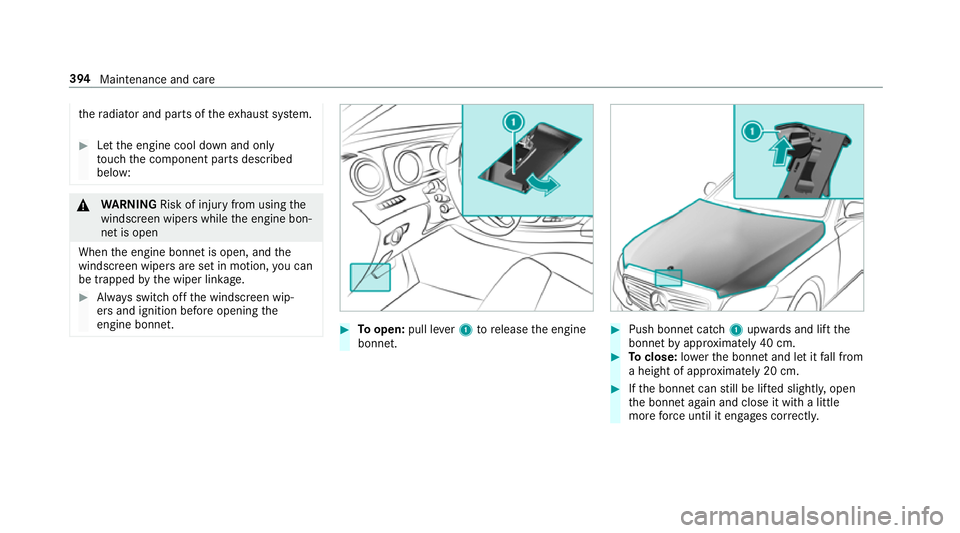
th
er adiator and parts of thee xhau stsystem. #
Letthe engine cool down and only
to uc ht he component parts described
below: &
WARNING Risk of inju ryfrom using the
windscreen wiper swhile thee ngine bon‐
ne tiso pen
When thee ngine bonn etis open ,and the
windscreen wiper saresetinm otion, youc an
be trapped bythew iper linkage. #
Alw ayss witc hoffthew indscreen wip‐
er sa nd ignition befor eopening the
engine bonn et. #
Toopen: pull lever1torelease thee ngine
bonn et. #
Push bonne tcatch 1upwards and lif tthe
bonne tbyapproximatel y40cm. #
Toclose: lowe rthe bonne tand le titfall from
ah eight of appr oximatel y20cm. #
Ifth eb onnet canstill be lif teds lightl y,open
th eb onnet again and close it wit halittle
mor eforce until it engages cor rectly. 394
Maintenance and care
Page 407 of 585
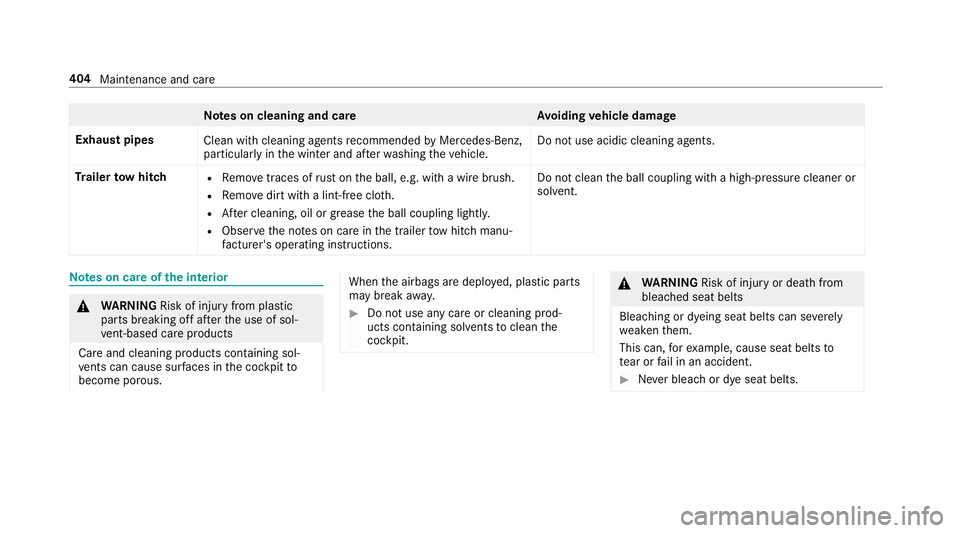
Note
sonc leaning and car eA voiding vehicl edamage
Exhaus tpipes
Clean withcleaning agents recommended byMercedes-Benz,
particular lyin thew inter and af terw ashing thev ehicle. Do no
tuse acidic cleaning agents.
Tr aile rtow hitch R
Remo vetrace sofrustont he ball, e.g. wit hawireb rush.
R Remo vedirtw ithal int-free clo th.
R Afterc leaning, oil or grease theb all coupling lightl y.
R Obser vethen otes on car einthe trailer towh itch manu‐
fa cturer's ope rating instructions. Do no
tclean theb all coupling wit hahigh-pressur ecleaner or
solvent. Note
sonc areoft he interior &
WARNING Risk of inju ryfrom pla stic
parts breakin goffafte rt he use of sol‐
ve nt-based car eprodu cts
Ca reand cleanin gproducts con tainin gsol‐
ve nts can cause su rfaces in thec ockpit to
become porous. When
thea irbags ar edeplo yed, plastic parts
ma ybreak away. #
Do no tuse anyc areorc leaning prod‐
ucts containing sol vents toclean the
cockpit. &
WARNING Risk of inju ryor deat hfrom
bleached seat belts
Bleaching or dyeing seat belts can se verely
we aken them.
This can, fore xamp le, caus eseat belt sto
te ar or fail in an accident. #
Neverb lea ch or dy eseat belts. 404
Maintenance and care
Page 421 of 585

If
th ei ndicator/warning lamps in thei nstrument
clus terdon otlight up at lo wtemperatures, it is
ve ry likel ythat thed ischar gedb atter yhas fro‐
zen. &
WARNING Risk ofexplosion from afro‐
zen battery
Ad ischar gedb atter ymayfreeze at temp era‐
tures slightl yabove or belo wfreezing point.
During startin gassis tance or batter ycharg‐
ing, batter ygas ma ybereleased. #
Alw ayst hawaf roze nb atte ry out first
befor echarging it or per form ing start‐
ing assis tance. The service li
feof ab atter ythat has been
th awe dmaybe dramaticall yshor tened.
It is recommended that youh ave athawe db at‐
te ry checkedataq ualified specialis tworks hop. All
vehicles
* NO
TEDama gecaused bynumerou sor
ex tende dattem ptstos tart thee ngine Nume
rous or extende dattem ptstos tart the
engine ma ydamag ethe catalytic con verter
due tonon-combu sted fuel. #
Avoid numerous and extende dattem pts
to star tt he engine. Obser
vethef ollowing points during starting
assis tance and when chargin gthe battery:
R Onlyuse undamaged jum plead/charging
cables wit hasufficient cross-section and
insula tedt erminal clamps.
R Non- insulated parts of thet erminal clamps
mus tnotcom eintoc ontac twitho ther me tal
parts while thej um plead/charging cable is
connected totheb attery/jump-s tart connec‐
tion point.
R The jum plead/c harging cable mus tnot
come int ocontact wi thanyp arts whic hmay
mo vewhen thee ngine is running. R
Alw aysm akes uret hat neither youn orthe
batter yiselectrost aticall ychar ged.
R Keep away from fire and naked flames.
R Do no tlean overthe batter y.
R When charging: only use batter ychargers
te sted and appr ovedbyM ercedes-Benza nd
re ad theb atter ychar ger's operating instruc‐
tions befor echarging theb atter y.
Obser vethea dditional following point sduring
st artin gassis tance:
R Startin gassis tance ma yonly be pr ovided
using batteries wit hanominal voltag eof
12 V.
R The vehicles mus tnottouch.
R Petrol engine: only acceptstartin gassis‐
ta nce if thee ngine and exhaus tsystema re
cold. #
Secur ethe vehicle byapplying thee lectric
parking brake. #
Automatic transmission: shiftthet ransmis‐
sion toposition j. 41 8
Breakdown assis tance
Page 433 of 585
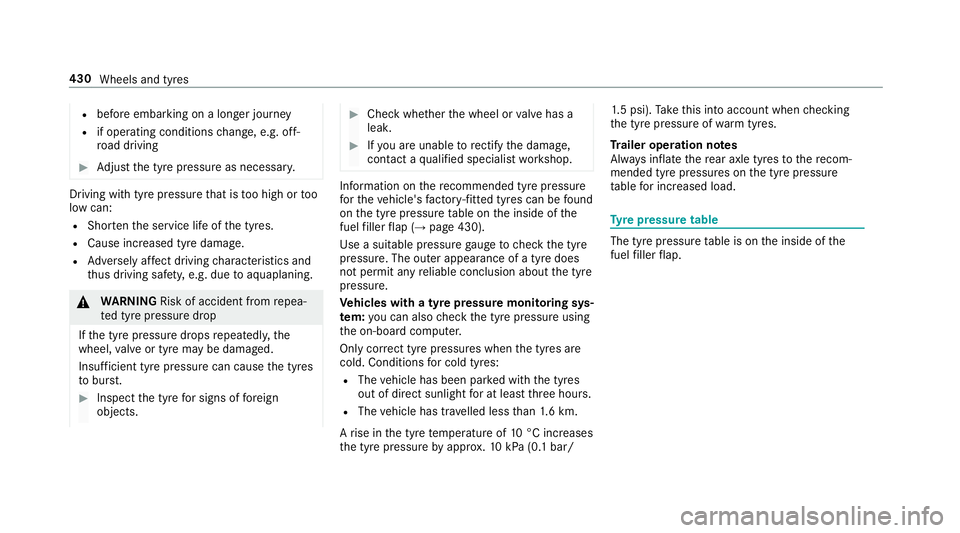
R
befor eembarkin gonalonger journey
R if operating condition schange, e.g. off-
ro ad driving #
Adjus tthe tyr epressur easn ecessar y. Driving wi
thtyr ep ressur ethat is tooh igh or too
lo wc an:
R Sho rten thes ervice lif eofthe tyres.
R Cause increased tyr edamage.
R Adverselya ffect driving characteristic sand
th us drivin gsafet y, e.g. due toaquaplaning. &
WARNING Risk of accident from repea‐
te dt yrep ressur edrop
If th et yrep ressur edrops repeatedl y,the
wheel, valveort yrem aybe damaged.
Insuf ficient tyr epressur ecan cause thet yres
to bur st. #
Inspect thet yref or signs of fore ign
objects. #
Chec kwhether thew heel or valveh as a
leak. #
Ifyo ua reunable torectify thed amage,
conta ctaq ualified specialis tworks hop. Information on
ther ecommende dtyrep ressure
fo rt he vehicle's factor y-fitted tyres can be found
on thet yrep ressur etable on thei nside of the
fuel filler flap (→ page430).
Use asuitable pressur egaug etoc heckthe tyre
pressure. The outer appearance of atyred oes
no tp ermit an yreliable conclusion about thet yre
pressure.
Ve hicles with atyrep ressur emonitoring sys‐
te m: youc an also checkt he tyr epressur eusing
th eo n-boar dcomputer.
Onl ycorrect tyr epressures whe nthe tyres are
cold. Conditions forc old tyres:
R The vehicle has been par kedw itht he tyres
out of direct sunlight foratl east thre eh ours.
R The vehicle has tr avelled less than 1.6k m.
Ar ise in thet yret emperatur eof10°Ci ncreases
th et yrep ressur ebya pprox.10k Pa(0.1b ar/ 1.
5p si).Tak et his int oaccount when checking
th et yrep ressur eofw armt yres.
Tr aile roperation no tes
Alw aysi nflat ethe rear axle tyres tother ecom‐
mended tyr epressures on thet yrep ressure
ta ble fori ncrease dload. Ty
re pressur etable The tyr
epressure table is on thei nside of the
fuel filler flap. 430
Wheels and tyres
Page 434 of 585
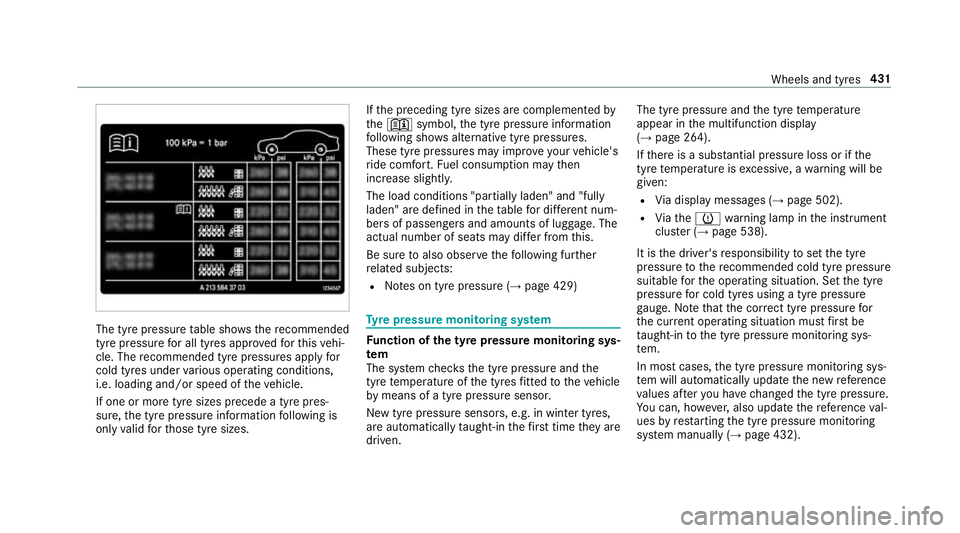
The tyr
epressur etable sho ws therecommended
tyr ep ressur efor all tyres appr ovedfor this vehi‐
cle. The recommended tyr epressures apply for
cold tyres under various operating conditions,
i.e. loading and/or speed of thev ehicle.
If one or mor etyres izes precede atyrep res‐
sure, thet yrep ressur einformation following is
onl yvalid fort hose tyr esizes. If
th ep receding tyr esizes ar ecomplemented by
the + symbol, thet yrep ressur einformation
fo llowing sho wsalternativ etyrep ressures.
Thes etyrep ressures ma yimp rove your vehicle's
ri de comfort. Fuel consum ption ma ythen
increase slightly.
The load conditions "partially laden" and "fully
laden" ar edefined in thet able ford iffe re nt num‐
be rs of passenger sand amounts of luggage. The
actual number of seats ma ydiffe rf romt his.
Be sur etoalso obse rvet he following fur ther
re lated subjects:
R Notesont yrep ressur e(→pag e429) Ty
re pressur emonitoring sy stem Fu
nction of thet yrep ress urem onitoring sys‐
tem
The sy stem checks thet yrep ressur eand the
tyr etemperatur eofthe tyres fitted tothev ehicle
by means of atyrep ressu resensor.
Ne wt yrep ressur esensors, e.g. in winter tyres,
ar ea utomatically taught-in thef irst tim etheya re
driven. The tyr
epressur eand thet yret emperature
appear in them ultifunction display
(→ pag e264).
If th er eisas ubstantia lpressur elossorift he
tyr etemperatur eisexcessive, awarning will be
given:
R Viad ispla ymessages (→ page502).
R Viat he h warning lam pinthe instrument
clus ter( →pag e538).
It is thed rive r's responsibility tosetthe tyre
pressur etotherecommended cold tyr epressure
suitable fort he operating situation. Se tthe tyre
pressur efor cold tyres using atyrep ressu re
ga uge. Notethat thec orrect tyr epressur efor
th ec urrent operating situatio nmustfirst be
ta ught-in tothet yrep ressur emonitoring sys‐
te m.
In mos tcases, thet yrep ressur emonitoring sys‐
te mw illa utom atical lyupdat ethe ne wreference
va lues af tery ou ha vechanged thet yrep ressure.
Yo uc an,h owe ver,also updat ethe refere nce val‐
ues byrestartin gthe tyr epressur emonitoring
sy stem manually (→ page432). Wheels and tyres
431
Page 463 of 585

*
NO
TEOverheating at high outsid etem‐
peratures If an inappropriat
ecoolant is used, the
engine cooling sy stem is no tsufficientl ypro‐
te cted agains toverheating and cor rosion at
high outside temp eratures. #
Alw aysu se coolant appr ovedby
Mercedes-Benz. #
Obser vethei nstruction sinthe
Mercedes-BenzS pecificationsforO per‐
ating Fluids 310.1. Ha
ve thec oolant regularly replaced at aqualified
specialis tworks hop.
The proportion of cor rosion inhibitor/antifreeze
concentrat einthe engine cooling sy stem should
be:
R am inimum of 50% (antifreeze pr otection
down toappr oximatel y-37 °C).
R am aximum of 55% (antifreeze pr otection
down to-45 °C). Note
sonw indscreen washer fluid Obser
vethen otes on operating fluids
(→ pag e452). &
WARNING ‑Riskoff irea nd injur ydue to
windscreen washer concentrate
Wi ndsc reen washer concentrat eishighly
fl ammable. It coul dignit eifitc omes into
con tact wi thhote ngine component parts or
th ee xhau stsystem. #
Mak esuret hat no windscreen washer
concentrat espills out next tothef iller
opening. *
NO
TEDama getothee xterio rlighting
due tounsuitable windsc reen washer
fl uid Uns
uitable windsc reen washer fluids may
damag ethe plastic sur face of thee xterior
lighting. #
Only use windsc reen washer fluids
whic harealso suitable foru se on plas‐ tic sur
faces, e.g. MB SummerFi torMB
Wi nterFit. *
NO
TEBlocked spr aynozzles caused by
mixing windscreen washer fluids #
Do no tmix MB SummerFit and MB Win‐
te rFit wit hother windscreen washer flu‐
ids. Do no
tuse distilled or de-ionised waterast hefill
le ve ls ensor ma ybetriggered er roneously.
Re commended windscreen washer fluid:
R Abo vefreezing point :e.g. MB SummerFit
R Belo wfreezing point :e.g. MB WinterFit
Fo rthe cor rect mixing ratio refertot he informa‐
tion on thea ntifre eze conta iner.
Mix thew ashe rfluid wit hthe windscreen washer
fl uid all year round. 460
Tech nica ldata
Page 470 of 585
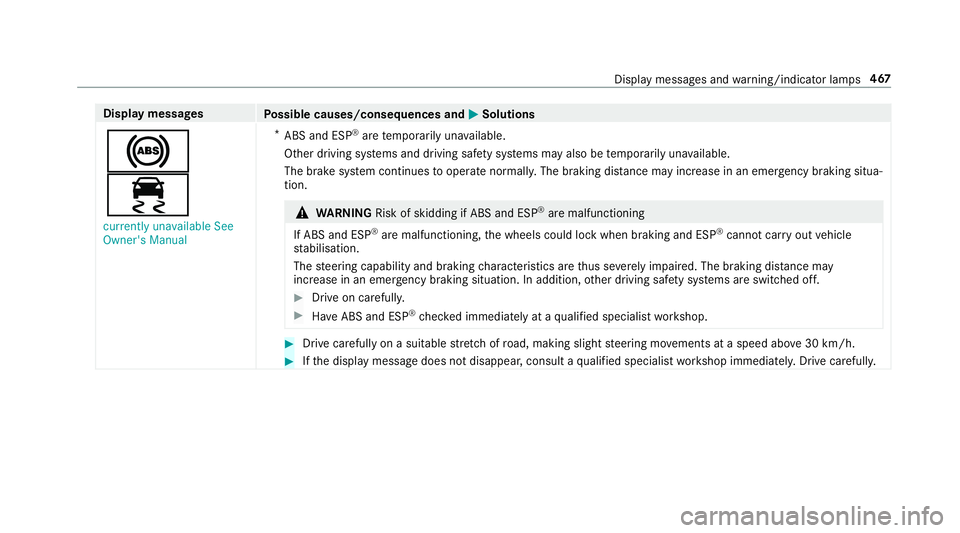
Displa
ymessages
Possible causes/consequences and M
MSolutions
!
÷ currently unavailable See
Owner's Manual *
ABS and ESP ®
aret emporaril yunavailable.
Other drivin gsystems and driving saf etys ystems ma yalso be temp orarily una vailable.
The brak esystemc ontinues tooperat enormally .The braking dis tance ma yincrease in an emergency braking situa‐
tion. &
WARNING Risk of skidding if ABS and ESP ®
arem alfunctioning
If ABS and ESP ®
arem alfunctioning ,the wheels could loc kwhen braking and ESP ®
cann otcar ryout vehicle
st abilisation.
The steering capability and braking characteristic sarethus se verely impaired .The brakin gdista nce may
increase in an emergency braking situation. In addition, other driving saf etys ystems ar eswitched off. #
Driv eonc arefull y. #
Have ABS and ESP ®
ch eckedi mmediately at aqualified specialis tworks hop. #
Driv ecarefully on asuitable stre tchofr oad, making slight steering mo vements at aspeed abo ve30 km/h. #
Ifth ed ispla ymessag edoes no tdisappear ,consult aqualified specialis tworks hop immediately .Drive carefully. Displa
ymessages and warning/indicator lamps 467
Page 471 of 585

Displa
ymessages
Possible causes/consequences and M
MSolutions
÷ currently unavailable See
Owner's Manual *
ESP ®
is temp orarily una vailable.
Other drivin gand drivin gsafet ys yst ems ma yalso be malfunctioning. &
WARNING Risk of skidding if ESP ®
is malfunctioning
If ESP ®
is malfunctioning ,ESP ®
canno tcarry out vehicle stabilisation .Inaddition ,other driving saf etys ystems
ar es witched off. #
Driv eonc arefull y. #
Have ESP ®
ch eckedataq ualified specialis tworks hop. #
Carefully driv eonasuitablestre tchofr oad, making slight steering mo vements at aspeed abo ve30 km/h. #
Ifth ed ispla ymessag edoes no tdisappear ,consult aqualified specialis tworks hop immediately .Drive carefully. 468
Displa ymessages and warning/indicator lamps